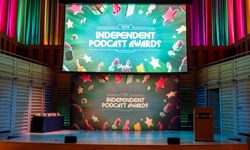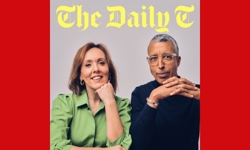
I recently wrote about podcasting for Publishing Executive magazine in America. For that article, my proof that podcasts are a thing was that former Vice President Joe Biden has one. If you’re interested to find out what ‘Joe wants you to know’, just shout, “Alexa, enable Biden's Briefing.”
Here in the UK, you can be sure podcasting is a thing because former Labour leader Ed Miliband has one. Reasons to be Cheerful is a weekly podcast about practical ideas to make the world a better place. Co-hosted by former Absolute Radio presenter Geoff Lloyd, the reinvented Miliband’s podcast has tackled topics from decriminalising drugs to urban regeneration, tax to transgender rights.
Politicians jumping on the podcast bandwagon might worry some publishers that we have reached peak podcast, but you can relax – podcasting is still very much a developing opportunity.
Podcasting: a brief history
Podcasts are definitely a thing, but they are not a new thing.
Way back in 2003, a former MTV presenter collaborated with a programmer to add media files to a blog’s RSS feed, combining the ease of blogging with the impact of audio. When they released a client application that would update as new content was uploaded, podcasting was born.
The term ‘podcasting’ came along soon after – Ben Hammersley used it in a 2004 Guardian article trying to explain the ‘online radio’ experiment. We’ve come to assume the ‘pod’ part has to do with Apple’s little music player, but it could just as easily stand for Portable-On-Demand (broad)Casting. The essence is: downloadable audio shows released as regular episodes.
For a decade, this non-linear radio format sat in the media world’s geekiest corner. A 2005 inclusion in iTunes made it easier to find podcasts and the introduction of 3G phones in 2008 made listening on the go easier. But podcasting really only made it to the mainstream in 2014.
That year, two things happened to fix podcasting properly in the public consciousness. The first was a stand-alone podcast app from Apple; the second was Serial, a 12-part podcast investigation of a 10-year-old murder case.
For the first-time ever, people were talking about a podcast the way they talked about TV programmes or movies. The first season of Serial reached five million downloads in record time and, at the height of its popularity, each episode was drawing 1.5 million listeners.
It’s hard to say what it was about Serial that captured the public imagination – the thrill of true crime, the potential injustice of a wrongful conviction, the slow reveal – but three years after its release, the podcast is still in the charts.
That level of success has spawned hundreds of true-crime imitators and galvanised countless other podcast producers into action. From about 3,000 podcasts listed on iTunes in 2005, there are now more than 400,000.
Growing audiences
As it has become easier to download podcasts, and programme choices have expanded, listener numbers have grown.
Predictably, growth is faster in the US. According to Edison Research’s 2017 Infinite Dial Study, overall familiarity with podcasting has reached 60 percent among American adults and the monthly audience for podcasts is 67 million listeners, up 21 percent year on year.
In the UK, research from RAJAR and Ofcom released in August suggests lower overall familiarity with just 24 percent of adults (15 or older) surveyed in Q1 2017 saying they had ever listened to a podcast. Regular listening also appears to be lower – only eight percent of UK survey respondents said they listened to a podcast on a weekly basis.
However, Ofcom also reported that 42 percent of survey respondents said they were listening to podcasts more often and 43 percent said they had maintained their listening frequency suggesting the podcast habit is growing in the UK.
Research from Spotify echoes this trend – the music streaming service reported 68 percent of its survey respondents said that they were more likely to listen to a podcast today than three years ago.
And whatever side of the Atlantic you’re listening, podcasting is not a mature medium. Anywhere from 40 to 75 percent of the population is still to be introduced to the format and in the UK, as many as nine in ten people have yet to tune in regularly.
Mainstreaming monetisation
As publishers are all too painfully aware, the hype surrounding the next big thing doesn’t necessarily translate to revenue. But increased media attention for podcasting accompanied by measurable audience growth has attracted cash, both capital investment and regular promotional spend.
While VCs are not putting up anything like the sums they have reserved for Silicon Valley start-ups and social networks, they are spending real money on podcast businesses. Production studios and networks Gimlet, HowStuff Works, Radiotopia and Wondery have all secured funding.
Regular revenues are also starting to develop. Growing from around $70 million in 2015 to $120 million last year, the IAB predicts US podcast advertising revenues reaching $220 million by the end of 2017 – growth of 85 percent.
The BBC’s early entry into podcasting may have skewed the commercial podcasting scene in the UK. The easy availability of quality podcasts without ads set an ad-free tone early on, so much so that podcast advertising in the UK is largely untracked.
But exposure to US podcasts sponsored by mattress companies, ingredient delivery businesses and email and web development services may be changing that. Network advertising sales, like that provided by the Swedish business Acast, are also making advertising an easier proposition.
Other monetisation options include direct sponsorship, increasingly popular for niche audiences, and subscriber revenues, generally fulfilled through the Patreon online membership platform. Live recordings, ticketed events where the audience comes to hear and participate in the podcast recording, are also becoming popular.
Professional podcasting
Making a podcast is not rocket science – you can make one on your phone. If you don’t believe me, just Google the phrase ‘make a podcast on your phone’… and that’s why there will soon be half a million podcasts on iTunes.
There’s no question that the growth of podcast output over the last two or three years has been phenomenal, but just like the blogosphere that spawned it, quantity seldom equates to quality. The fact you can make a podcast on your phone means it’s easy to make a really bad podcast on your phone.
Of the 400,000 or so podcasts listed in Apple’s podcast store, just one percent get anywhere near the 50,000 downloads an episode considered to be the benchmark for a commercially viable show.
A ratio of 100-to-1 commercially viable podcasts is the definition of amateur hour, and that is the heart of the podcast opportunity for publishers.
Professional publishing teams that can set and stick to a schedule, tap expert content creation talent and marshal print and digital audiences at scale, have a real shot at pushing aside some of the 396,000 underperforming podcasts currently clogging up the marketplace.
Even niche publishers who won’t clear that 50,000 benchmark can leverage the trust and credibility that comes with an established publishing brand and its associated audience to add a sustainable podcast to their product mix.
The podcasts currently produced in the UK are many and varied. There’s the occasional international hit, like My Dad Wrote a Porno, but most publisher podcasts sit squarely with the publication’s core subject matter: it’s no surprise that The Empire Magazine Podcast is all about movies.
Echoing niche newsletter strategies, some publishers are zooming into a specific area of audience interest – the UK’s Metro newspaper produces Mentally Yours, a mental health podcast; The New Statesman makes at least four weekly podcasts reflecting the content it publishes in print and online every week, from politics to arts.
The Guardian’s ad-hoc Audio Long Read series takes longform articles from the paper and reads them for listeners, but the paper has also recently ventured into audio drama with the launch of Adulting, a series of ten-minute episodes.
Podcasting in the B2B space is, by definition, specialist, and tight subject matter focus and the importance of expert opinion is perfect podcast fodder.
The Business of Fashion is a daily information resource for fashion creatives, executives and entrepreneurs internationally. The BOF Podcast features a series of new and archival conversations with designers and other fashion industry insiders from Tommy Hilfiger to will.i.am. An initial six-episode launch in October 2017 has stretched to twenty episodes with plans for two new shows every week.
Getting started
Although you can make a podcast on your phone, you probably shouldn’t. A decent desk mic and a nice quiet room without echoes are fairly fundamental, as are decent lapel mics if you want to record interviews away from your office.
There are many, many podcast hardware and software guides out there – my favourites are produced by the good people at The Podcast Host who also do a very good podcast about podcasting, but get on Google and you’ll find loads of advice and information.
In the long run, way more important than your set up, is your strategy and here are a few things you will want to think through as you prepare to deliver on-demand audio:
* Content: The breadth and depth of content published in print and online is matched only by the possibilities for podcasting. That said, the tighter the niche you target, the more loyal the audience will be. The secret to podcasting is to create shows specific enough to be adored, but inclusive enough to attract an audience at a scale that sponsors and advertisers will appreciate.
* Length: There’s no such thing as too long in podcasts, only too boring. The conventional wisdom is that 20 to 30 minutes is the ideal length for a podcast, echoing the average commute, but shorter, snappier daily shows are starting to show up especially in news and business. At the other end of the spectrum, many of the most popular podcasts run to an hour or more, especially interview shows.
* Frequency: Podcasts episodes are launched on all sorts of schedules – daily, weekly, every two weeks, once a month. The sensible thing to do is to set your frequency to match the information cycle in your market. Also think about production requirements – how hard will it be to research, record and publish your content. Producing a ‘chat show’ takes a lot less time and effort than big-ticket audio dramas.
* Discovery: Discoverability is a huge challenge for podcast producers. Regular calls for reviews and ratings on Apple’s podcast store highlight the same sort of discoverability nightmare publishers suffered through with Apple’s Newsstand. But publishers have the advantage of direct audience contact through email newsletters and social media; converting existing magazine and website readers to listeners is easier than finding them fresh.
* Revenue: Advertising networks like Acast offer an easy entry point for publishers into promotional revenue. But if you have established advertising sales resources and relationships, direct sales will offer a more profitable route. There will undoubtedly be client education involved, along with management of expectations around reach and response, but long-term, opportunities to develop tailored advertising content within a podcast will support audience engagement.












